To celebrate the nation’s triumphant return to the pub, we’ve teamed up with korev – a refreshing lager, born in Cornwall, with a deep heritage in surfing and proud sponsors of the Wavelength Drive-In Cinema – to bring you a brand new series here on Wavelengthmag.com.
Over the next few months, we’ll be heading to some of the South West’s most iconic surf towns and sitting down at the local with a few legends of the scene for a chat about the history, the culture and the characters over a couple of cold pints of korev.
Home to the country’s first surf community, the sleepy fishing village turned stylish seaside resort of St Ives seemed the natural place to start. It all began back in the early ‘60s, when two sets of brothers, the Williams and the Griffins, learnt to stand up on the big wooden rescue boards used by the town’s Surf Life Saving Club.
It wasn’t long before the boys sought craft more suited to the job and in ‘61, Pete Griffin sent a letter to Surfer Magazine looking for tips on how to build the modern boards that appeared in its pages. Soon after, they got their hands on some refrigerator foam, which they glued together, shaped and glassed, creating the first batch of foam and fibreglass boards built anywhere in Britain.
The town’s fledgling scene gained a major boost the following year when a famous American surfer called Dave Rochlen turned up at the Griffin’s house one afternoon, having got their address from a friend at Surfer Magazine. Apparently, he was on his way to the Alps for a ski trip and after hearing rumours of waves in England, decided to lay over and investigate. His visit had a profound impact on the small surf community, which set about crafting itself in his image.
By the ‘70s, word had spread about St Ives’ fun waves and vibrant nightlife and a steady stream of travelling surfers had begun to arrive from all over the world. Among them were the first two of our pub garden guests, Tim Whitefield, originally from South Africa, and Stef Harkon, originally from Liverpool.
Both spent the following four decades lifeguarding the beaches, while Tim also went on to establish the now legendary St Ives Surf School at Porthmeor Beach, teaching the next generation including multiple British Champ Jayce Robinson and leading female free surfer Tassy Swallow, who also joined us around the table.
As we took our seats on the terrace of the beautiful Pedn Olva, perched high on a cliff overlooking the harbour to the south and the bay of St Ives to the north, and five cold pints of korev arrived glistening in the evening sun, I invited Tim to begin with his earliest memories of the town….
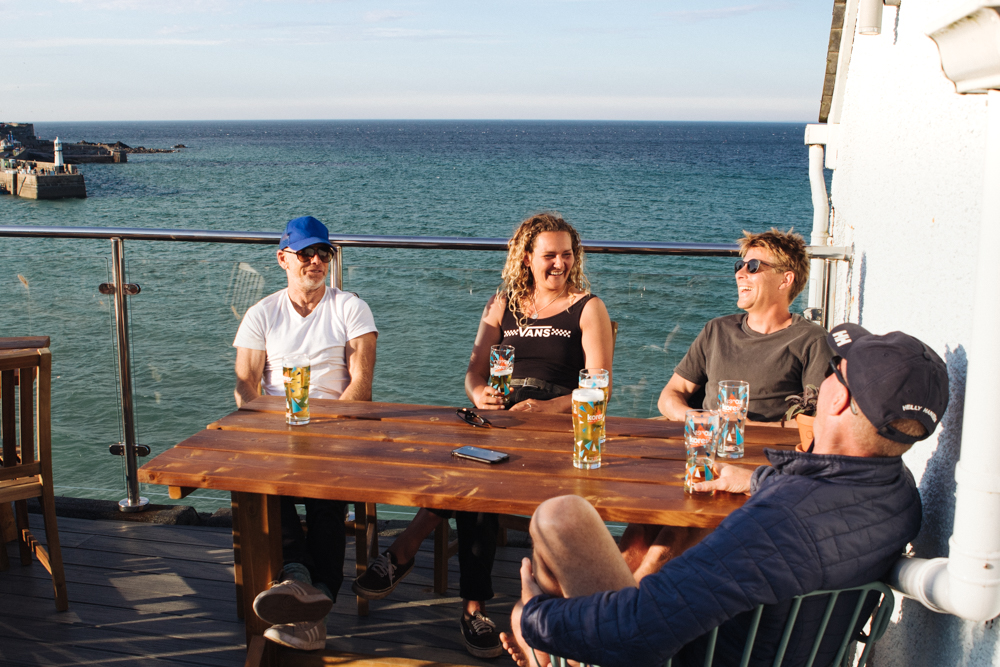
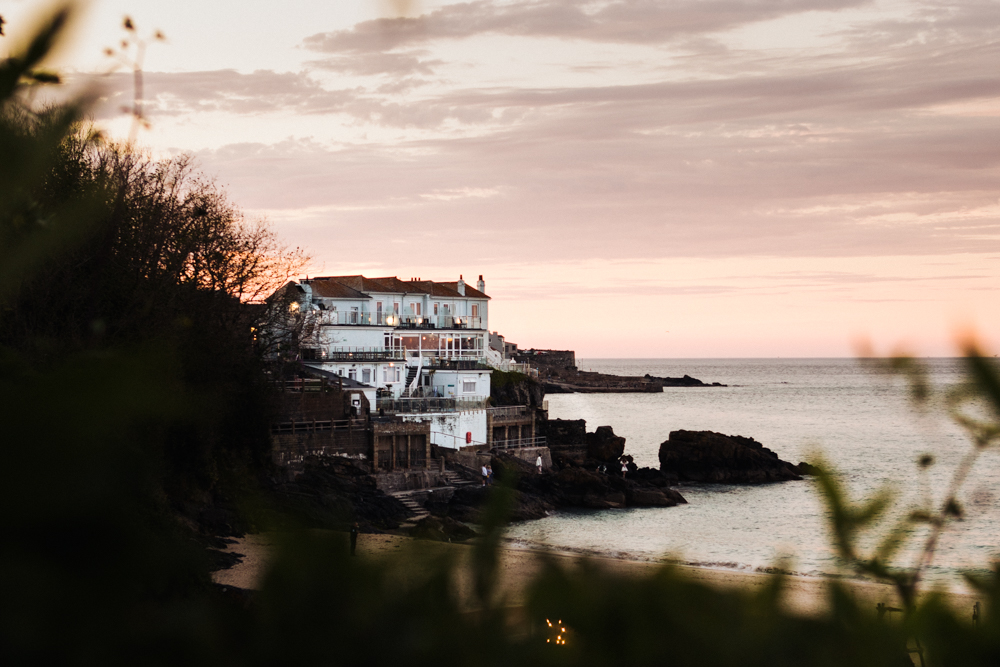
The group get stuck in on the Pedn Olva’s sun drenched roof terrace.
TW: I got here in April ‘77, when I was 16. I remember driving down Tregenna Hill and stopping outside the surf shop owned by Charles Williams. He was one of the best in Britain in the ‘60s and the dark lord of performance surfing down here along with his twin brother.
SH: He was also one of our first head lifeguards, a big tall, good looking dude.
TW: The shop was called the Silver Surfer. It was all incense burning, bells ringing with tye-dyed t-shirts and all these classic single fins in a rack. We drove around the corner past Porthmeor and it was 3-4 foot pumping, offshore. Packed on the beach but only about 4 guys out, I was like wow, this is incredible. And I never left.
LG: And where had you come from?
TW: South Africa originally. We just arrived in Southampton and turned left.
SH: With the map upside down! He meant to go to Scotland…
TW: That’s true my dad’s Scottish, he probably did mean to end up there. But we turned left, wanged it down here and it was perfect. It could have been onshore, ten-foot, and I’d have gone this is shit.
LG: And was the surf shop a focal point for the community at that time?
SH: Definitely, It was like a connection to the mainframe of this new existence. Going in there and getting a surf magazine was like a spiritual experience. You’d walk in and see resin tinted boards, sand on the floor with the smell of sex wax and incense burning.
TW: It was long before the internet, so you’d send off for mail order stuff. There was Moroccan trading beads and guys with long hair, big pintail single fins and wetsuits that you wouldn’t recognise now. It was like this club that you were in. In cities, they’d have a smokey snooker club. For us, it was the surf shop.
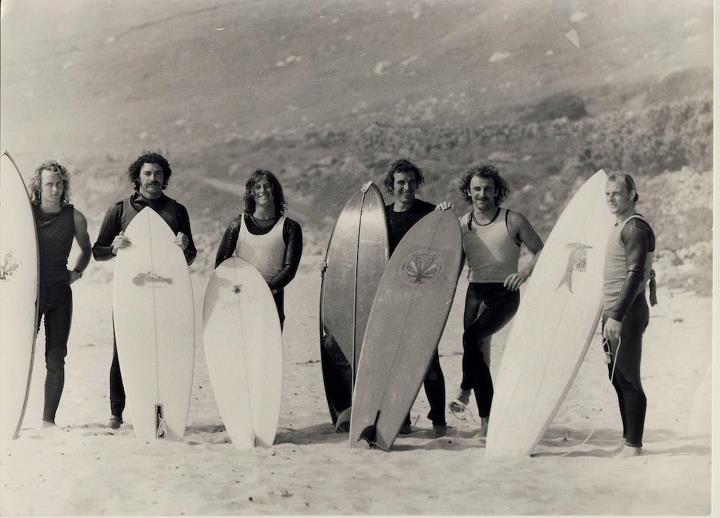
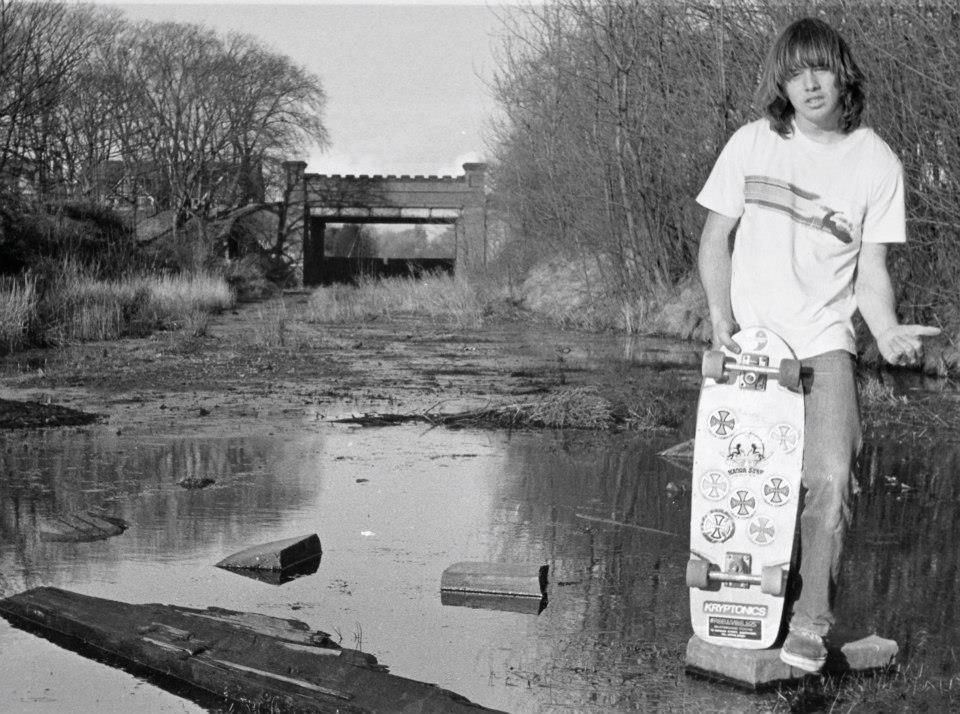
(1) ’70s Cornish surf legends Colin Wilson, Charles Williams, Tigger Newling, John Nile, Graham Nile and Tim Heyland. Image: BSA Archive via vintagesurfboardcollectoruk.blogspot.com. (2) Stef Harkon in Southport in the ’70s. Image via Sheenagh Burdell.
LG: When did you arrive Stef?
SH: I met Tim on what must have been his first or second year here. I would come down from Liverpool with my folks, my dad would drop us off for 6 weeks at a time and go off and do whatever with the army.
TW: He rocked up with a massive fucking perm and a tash. Him and all his scouser mates. I didn’t understand a word he was saying!
SH: I was rocking it mate. We all used to hang out and skate and then go surf and Tim had a board which I’d borrow. The thing about back then was it did all feel a little bit different. It felt more subcultural than it is now. If you were driving past someone coming back from the beach with boards on their roof, you’d slow up, flash your lights and they’d give you a thumbs up if it was any good or thumbs down if it was crap and that was your surf check. We probably knew everyone who surfed between here and Newquay.
TW: We had a pub that was full of surfers wearing surf gear and just talking about the waves, saying things like ‘have you seen that 924 low that’s coming out of the south?’ Back then there was still a strong Methodist religion here, you had the rugby players on one side of the pub, the fisherman on the other, surfers on the other. You’d never mix.
LG: And was there tension between those groups?
SH: Oh yeh. I remember one scrap we had once, in the gardens at the bottom of Bedford Road. We’d all come out of Peggotty’s, the one night club, and there was a place where they made pasties overnight, so we’d all go down at one o clock and get them hot out of the oven. It all kicked it off with these rugby players and all of a sudden there was just a volley of pasties getting lobbed around.
TW: Surfing then in this small little fish town was still a subculture, it was still like bums on the dole, smoking weed. The fishermen would just say get a fucking job, you know I’m out at sea hauling pots all day long, with calluses on my hands.
SH: Back then you had to wear two wetsuits in the winter, a steamer, with a shorty underneath. It wasn’t easy, there was nothing accessible about it. Even just checking the surf, we’d have to wait till 6 o clock to see a hand-drawn weather chart, with isobars around it and matey standing in front of the low. That mystique was part of the draw.
TW: Of course, there’s a massive danger of the likes of Stef and I looking back with rose-tinted glasses going “it was so much better in our day.” Then, in 20 years time, Tassy and Jayce will say remember when we were having beers at the Pedn Olva? Man, it was good then.
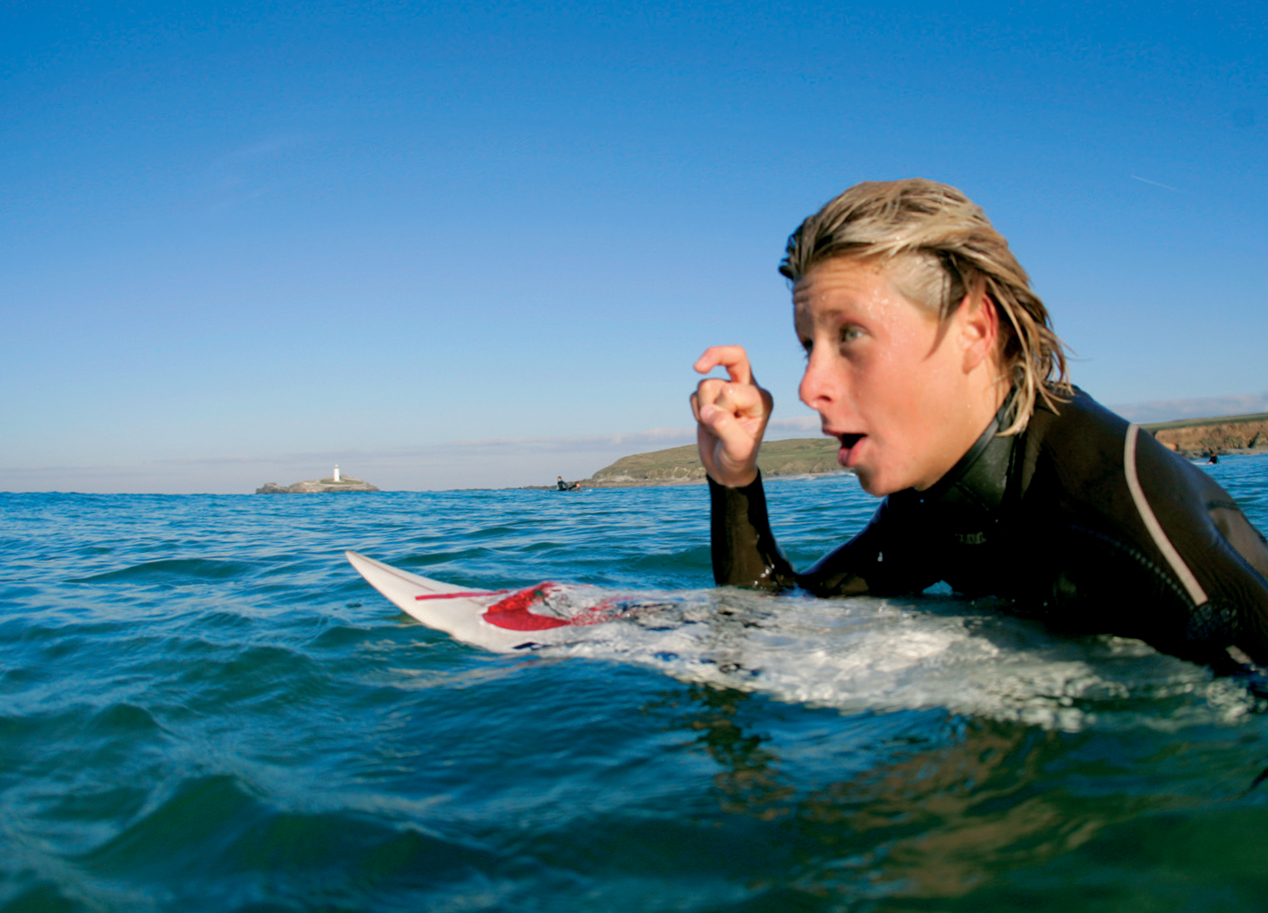
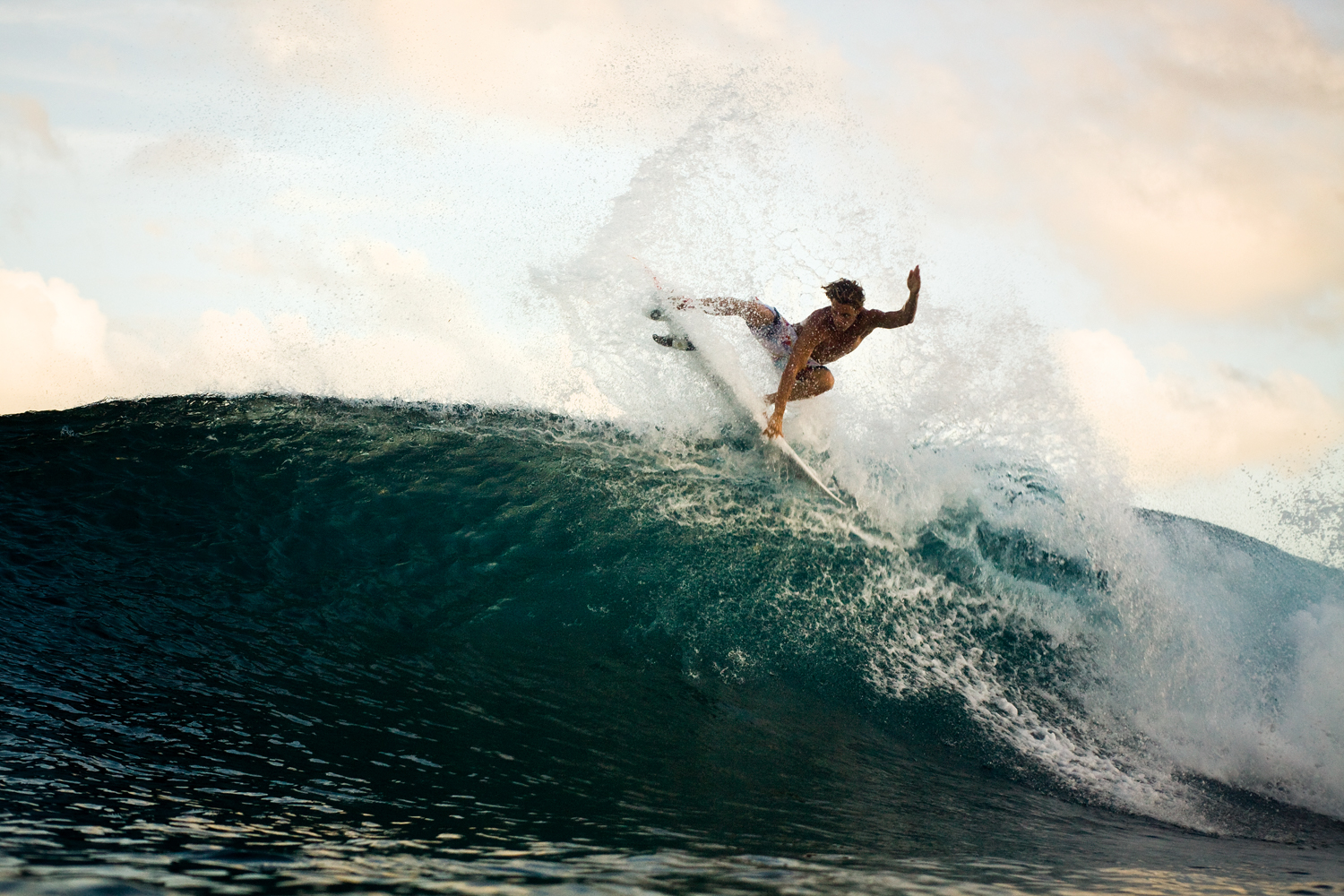
(1) A young Jayce Robinson making friends at the mighty ‘Meor. Photo Jordan Weeks. (2) Jayce, a little longer in the tooth, blowing tail in the tropics. Photo: Greg Martin
LG: Jayce, tell me about how you got into surfing?
JR: Tim taught me, back in the late 90s at St Ives Surf School, and Stef was there as well, making sure we didn’t drown.
TW: There was a whole crew of them around that time; Jacob Down, Harris Rothschild, Billy Norways, all those guys, they were just a crop of kids who were frothing and just exceptionally good.
TS: I remember when I first came and I was like oh my god why does everyone rip in St Ives…
LG: How did you end up here Tassy?
TS: We used to live up in Yorkshire and my parents moved to Zennor because they were coming down virtually every weekend. I actually learnt to surf over at Godrevy, and then as soon as I was like 8 or 9 and started competing, I was down at Pothmeor all the time.
I was going to Truro school because my parents worked up there, but I got kicked out in year 9 because I was travelling so much and apparently surfing wasn’t a ‘sport’. After I left they started using my picture on the brochure, saying ‘supporting international athletes’ (laughs) And now they’ve got a full surf academy going.
JR: You paved the way then Tass! That’s how it happens though isn’t it. The first people are shamed…
TS: My parents actually had it proper gnarly from all the teachers and other parents just saying that they were being negligent by letting me compete abroad and go on all these trips. I think if they weren’t quite sure that that they were happy for me to do it, we could have got swayed by the school at that point.
SH: That’s just how things always start. Even when I started lifeguarding with Tim, we were told ‘oh you’re wasting your time, it’s not a proper job.’ We knew it was a proper job. Even when you two were growing up, surfing was still peripheral and some people still couldn’t see any value in doing it, whereas now everybody can see that it’s a legit culture. People have realised that our fishing has gone, our farming is disappearing. Lifeguarding, having a surf school or working at a surf school, these are the new farming, these are the new fishing. That’s the evolution of a small coastal town.
TW: It’s a double-edged sword. To make surfing acceptable to the wider society, you’re absorbing this cleaner cut version of it into your own sub-culture and it becomes the thing you were railing against the whole time.
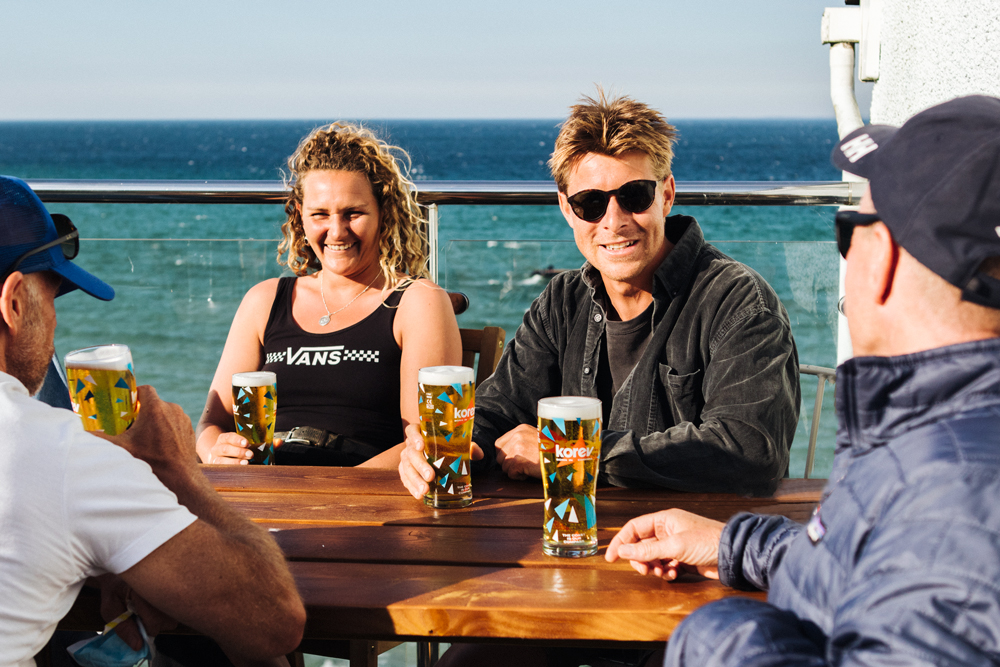
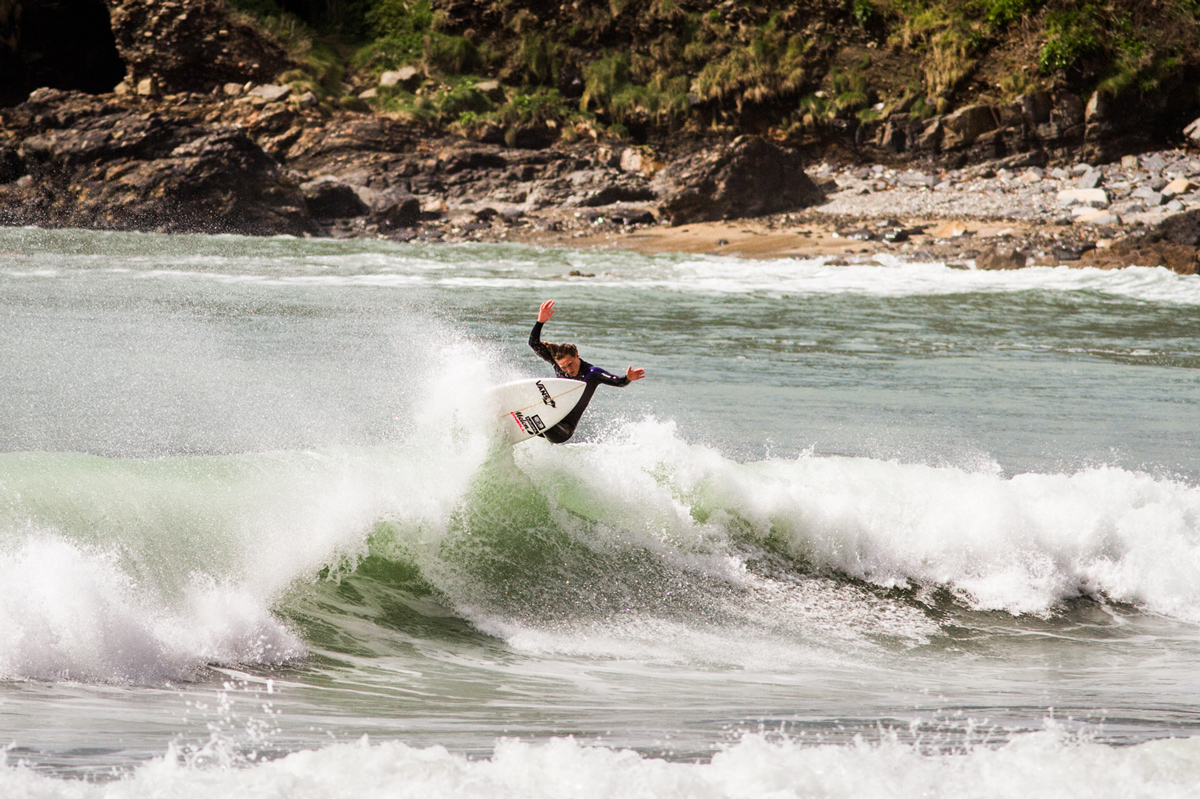
(1) Two pints of korev & two of St Ives’ finest high-performance exports. (2) Tassy off the top on the south coast. Photo: @lugarts
JR: Yeh, I mean I love Porthmeor, but it’s not even worth surfing there sometimes unless you want to ride on someone’s back from Manchester. But, like you say, it’s a double-edged sword because we all get paid from it.
SH: We just need to re-frame the way we think about it. Because it’s still sub-cultural really and still a unique thing for us all to be involved with.
LG: Stef and Tim, can you tell me about some of the interesting characters you remember turning up when the scene started growing rapidly in the ‘80s?
TW: We had our surfing crew, this tight-knit local community then suddenly these guys came down in vans from Fleetwood, in the North West. They were legit, they’d been to Hawaii…
SH: Brendon had surfed Pipeline in a pair of green flash pumps and a full wetsuit because he didn’t want to walk on the reef. He walked past the lifeguard hut and they said ‘this is Pipe!’ He told me he heard the lifeguard go ‘check this arsehole out’
(all laugh)
They’d come from surfing the Fleetwood funnel, the Loch Ness Monster of waves, a big A-frame that breaks up a slipway in Fleetwood. He’d go ‘I’ve surfed the Fleetwood funnel me’ and we didn’t believe it was a wave until someone sent me a photo of the cover of a fishing magazine, Angler weekly or something, and matey’s casting off into a shore break and there’s like a Hossegor a-frame… in Fleetwood!
They just became part of the fabric of the surf community, there was no one questioning ‘oh you’re not from here,’ the only localism we encountered was when we would go to little towns like Porthtowan or Aggie and we’d turn up with 8 of us in one person’s van.
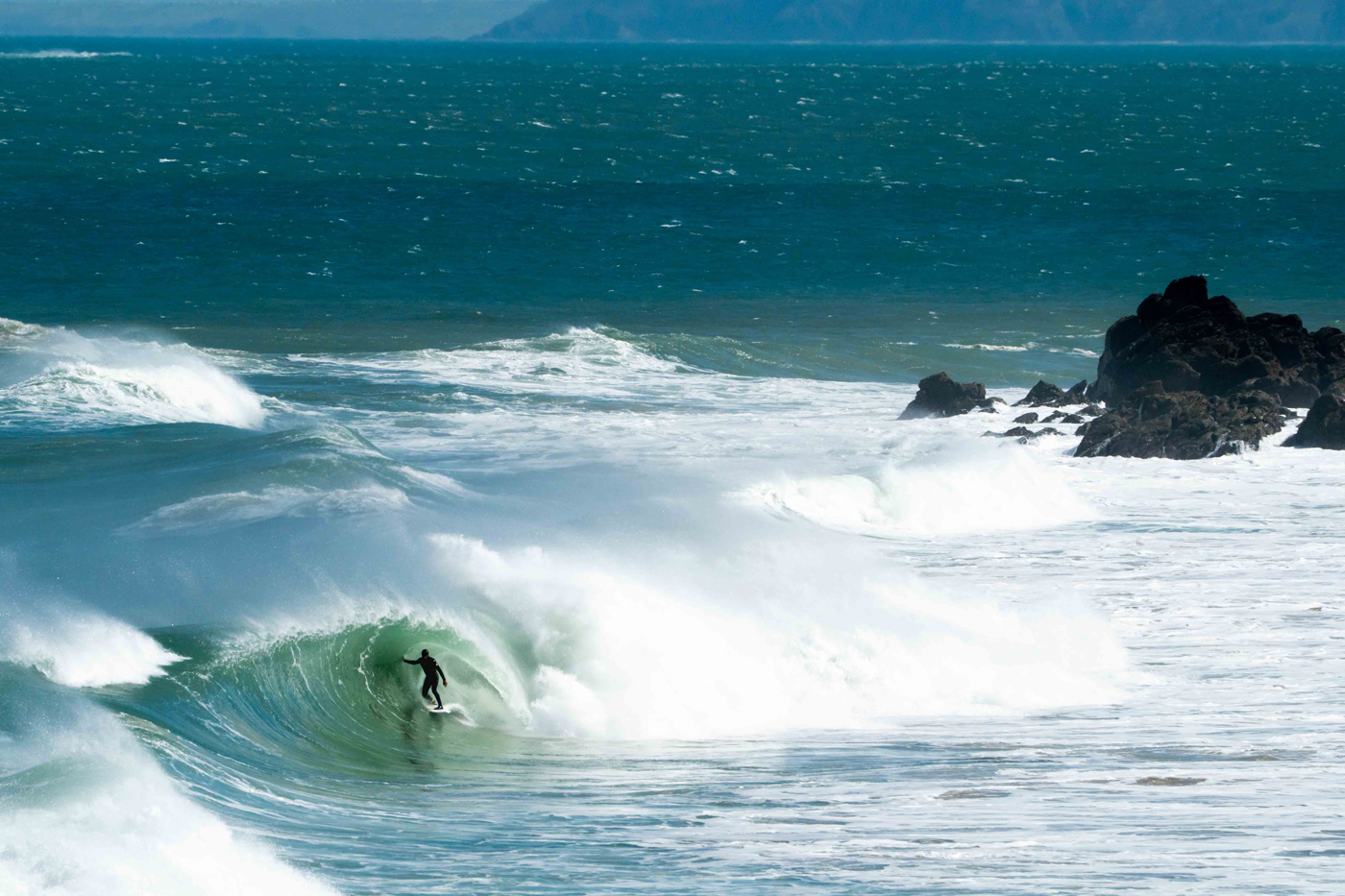
Jayce standing tall at the Boiler, captured by one of the town’s talented crop of surf snappers, @warbey.
LG: On the subject of the waves around here, there’s none more iconic than Boilers at the western end of Porthmeor beach. Can you tell me how it got its name?
SH: In the 1930s a ship called the SS Alba wrecked off the edge of the island. It left most of its remnants behind, including a big piece of the boiler which creates a barreling right-hander at low tide. When it was still fairly intact it had a spout on top and when it filled up with water it would go tsshhh, like a whales spout! It would make you jump.
JR: It still does it now, on the odd occasion.
TW: It used to be all smooth, but the seaward side of it now has a big cavity in that’s razor-sharp. I was checking it out on the paddleboard the other day, and you wouldn’t want to fall in front of it now.
JR: I’ve it hit before, but never very hard. You’re always just on the right side of it. But when you’re in the barrel, or if you get a closeout, it’s there!
TW: Many years ago, you used to be able to see the whole outline of the boat. When we first started guarding in the ’80s, you used to be able to take a snorkel and mask and swim through the plates.
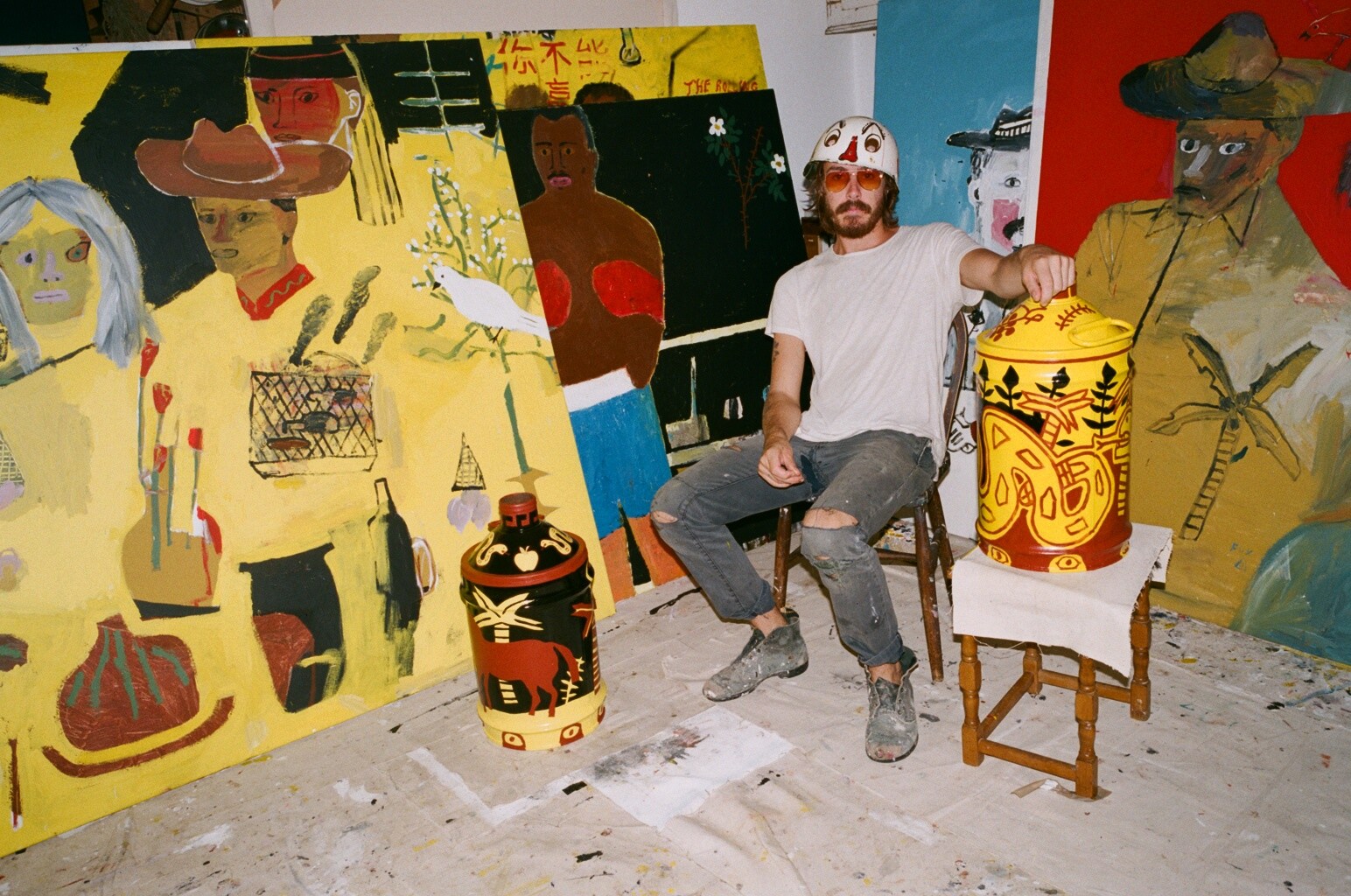
Danny Fox caught his first big break in 2014, with a solo exhibition at the Cock ‘N’ Bull gallery in East London. Since then, he’s relocated to LA and developed into a highly sort after painter of global renown. Image courtesy of the artist // Cock ‘n’ Bull gallery
LG: The town’s connection to the arts dates way back, but more recently there have been a few really successful artists to emerge from the surf scene as well, like acclaimed painter Danny Fox, now based in LA, and photographer Jack Whitefield – who just happens to be your son Tim. Can you tell me about that crossover?
TW: I think St Ives’ connections with surfing and art is quite an integral thing. But with Danny, he has this whole thing with LA, but actually, he’s a homeboy, a Cornish boy and a surfer, who just falls back in with the crew when he’s back here. All of those guys have this almost beatnik connection with what they’re doing in a creative kind of way, but then they surf at the same time which is massively creative as well. I think the artists primarily came down here for the light and the environment and as surfers, we’re immersed in that environment and in that whole kind of experience. It’s a tangible cultural thing that’s shared between all of us. I mean fisherman too, but they don’t express it… there’s only one fisherman I’ve ever known who does art, the old harbour master, Eric Ward.
SH: I think art was seen as being a bit of a frivolous thing to be into at times, especially in places like this that relied on solid industries like fishing and farming and, going back generations, mining. They’re such hard grafting jobs and so anything frivolous – which you could also argue surfing is – was seen as a waste of time. Whereas now, with the younger generations like Danny and Jack they’ve been given the opportunity to be freer because it’s not like people are going to say you shouldn’t be doing that mate, you should be doing a proper apprenticeship. They’ve been given the opportunity.
LG: Do you think the surfers and the artists stuck together in the early days because they were both doing things deemed as frivolous by others?
SH: There was definitely a common thread.
TW: On a Friday night, we’d go down to the pub and the landlord would do loads of food and all the artists from Porthmeor studios would come down, play pool and hang out. We had this kind of shared conduit, the same appreciation for what was going on.
SH: I think because we knew we weren’t going to get judged by them too, because most of us were trying our hardest not to get a job.
There was no way of making surfing your profession because there wasn’t any structure in it beyond enjoyment. I got drawn into the whole competition thing, we all did, but at the end of the day we felt more kinship with the bohemian arty people, even though I’m a sporty person.
JR: I remember when I first started doing contents… I don’t know how but my dad found out about one and said ‘do you want to go in it?’ And I won it, and then I thought, I like winning. But then when it went serious and Ripcurl took me on and I started competing in Europe and around the world with them I always had this sense that I didn’t like it. I felt like “I’m not like them,” like there was this edge that I didn’t have. And I still feel it now.
The generation I looked up to was Lowey, Charlie and Timbo [Symonds] and Patch [Wilson] and those guys weren’t competitive they were just raucous and good surfers and chargers. And I really liked watching them and watching their style.
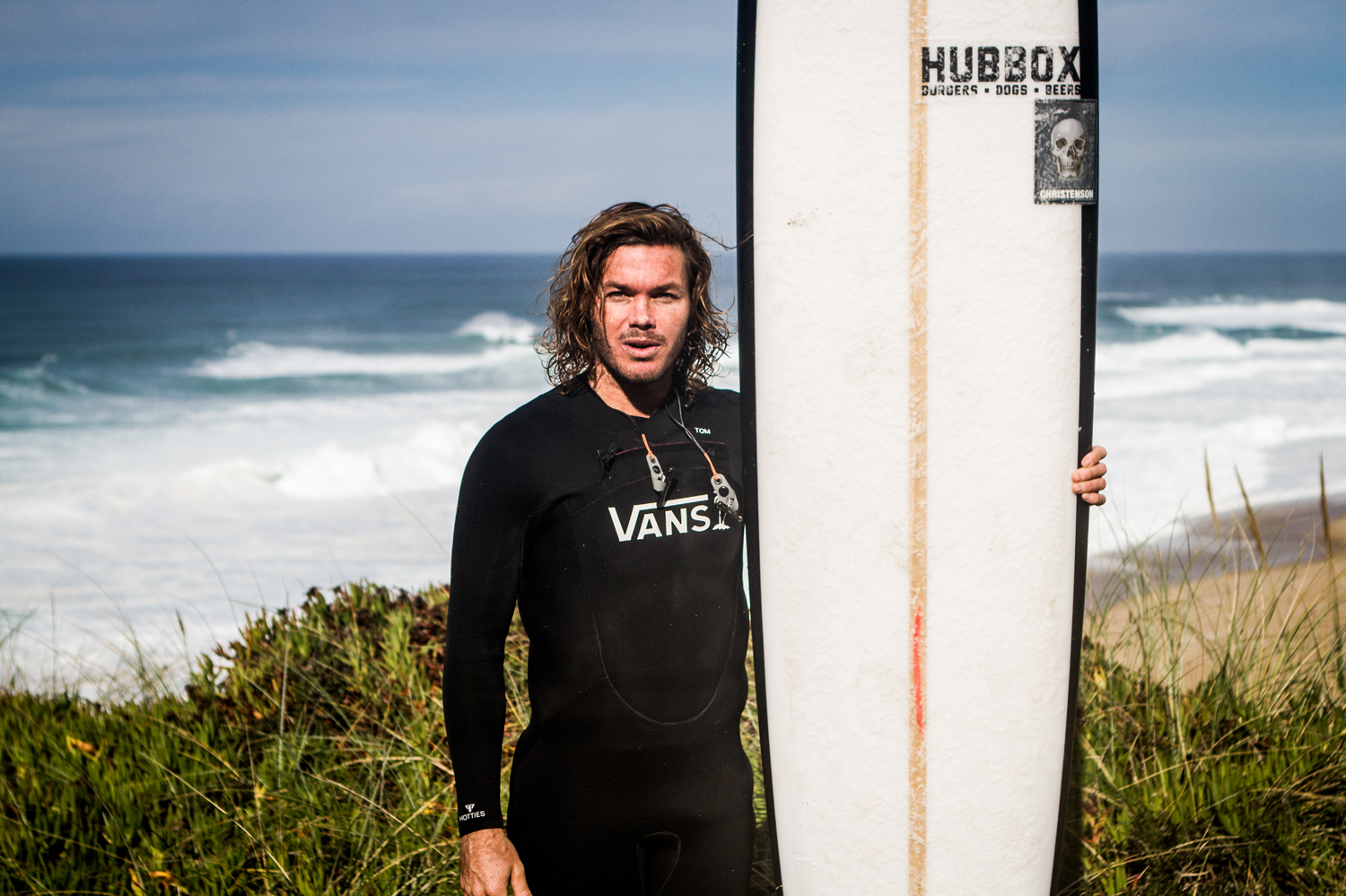
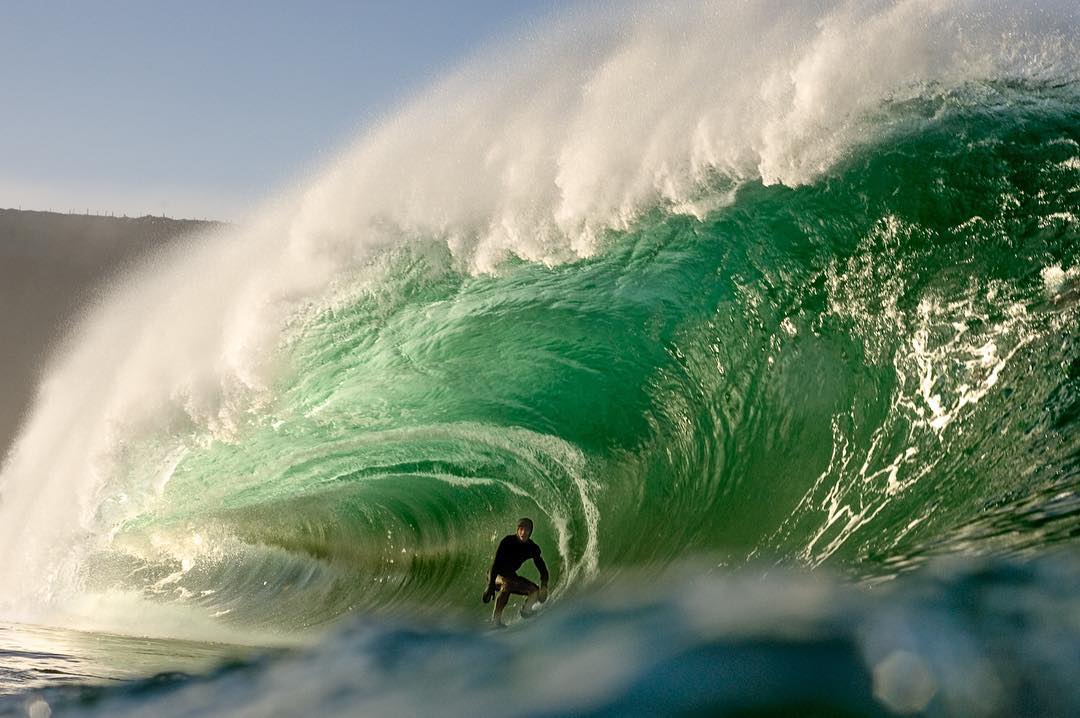
After setting off for Ireland in his late teens Tom Lowe quickly became one of Britain’s foremost big wave pioneers. Since then, he’s cemented his reputation globally with numerous Big Wave World Tour appearances and a nomination for Best Overall Performance in 2020. Photos: (1) @lugarts, (2) @georgekarbus
LG: Having grown up with those guys, have you got any insight into how Lowey and Patch became such incredible big wave surfers?
JR: They’re just completely different characters. I think Lowey pushed Patch into that sense of adventure. Tom was just guarding and washing dishes and he was always a nutter. He would do something every day that would make you go ‘you fucking crazy bastard.’ You know, chuck a banger in the bank, or skate down the middle of the road naked and he took that to his surfing. He said I’m not a kid anymore, let’s go charge and I’ll do something crazy in my surfing career because I’ve got the talent. He had a lot of energy, a lot of fire that he needed to get out.
SH: I knew his dad from playing football, he was from Liverpool and he wouldn’t mind me saying, he was quite a full-on fiery character at times. And I think with Tom, he didn’t have great surfboards when he was growing up, you know he surfed a minimal, for a long time, which I watched smooth his surfing out.
LG: Was there an older generation of surfers who inspired those guys?
SH: We had a really good crew of core bodyboard chargers, like Mike Stevens, that guy’s a fucking legend!
JR: He’s probably the guy who Lowey looked up to the most.
SH: He went to Hawaii and Waimea was on, 40 foot with all the big hitters out; Ken Bradshaw, Brock Little, Mark Foo, and then little Mark Stevens from St Ives on his boog just goes out and starts surfing the shore break. And they’re all like ‘who the fuck are you?!’ And he says ‘I’m fucking Mark Stephens from St Ives!’ (all laughing)
Same trip, he was with a bunch of guys Martin Craven, Johnny Wells, James Hardy, sitting at a bus stop in Hawaii. Some guy turns up, bit of a gangster, and starts saying I’m gonna kick your ass you haoles and shows them he’s got a gun. Mark just stands up to him and goes ‘oh you’ve got a gun mate… Tell you what mate why don’t you stick it in my mouth?’ And the guy’s like ‘what?!’ and goes to leave and the rest of them all are pissing themselves and crying at the bus stop, and Mark just starts legging it down the road after the bloke going ‘shoot me!’ ‘shoot me!’
(all laugh)
Mark Stevens’ legendary session in the Waimea shorebreak (that’s him dropping in at the 0.14 second mark) as featured in the film ‘Underground Tapes Fuel’.
TW: He goes to Australia on this trip and this prizefighting circus turns up and Mark says ‘I’m going to enter,’ and ends up beating the undefeated guy. The whole crowd were going ‘Pommie Pommie!’ And he made the national press. And the guy who owns the boxing circus said we want you to come on tour with us!
SH: I’ve got one more… when he went to Mexico to surf Puerto Escondido, someone told him the national Mexican bull riding competition was inland a bit. Mark goes, I’ll go. He entered in a pair of boardies and he came third or something! And he won a purple sash for the bravest ride.
LG: Who are some of your other favourite underground core lords from St Ives?
JR: What about ‘Jubes’? The name says it all. Julian Kerr. Super stylish quiet dude who just got tubed.
SH: There used to be a red phone box at Porthleven, and Jubes was so committed, he’d go and sleep standing up in the phone box, I’m not even bullshitting! He’d get dropped off the night before in the middle of winter and just stand in there all night. And then wake up and go and get tubed.
TW: I remember being on the underground in London and looked up and there’s a picture of Jubes at low tide Boilers, in the tube! It was a national advert. I was telling everyone on the tube!
(all laughing)
LG: Thanks folks. It’s been a pleasure.
Join us for a colds pint of korev overlooking Watergate Bay this summer at the Wavelength Drive-In Cinema. Get your tickets here.
Cover photo: @photogregmartin
